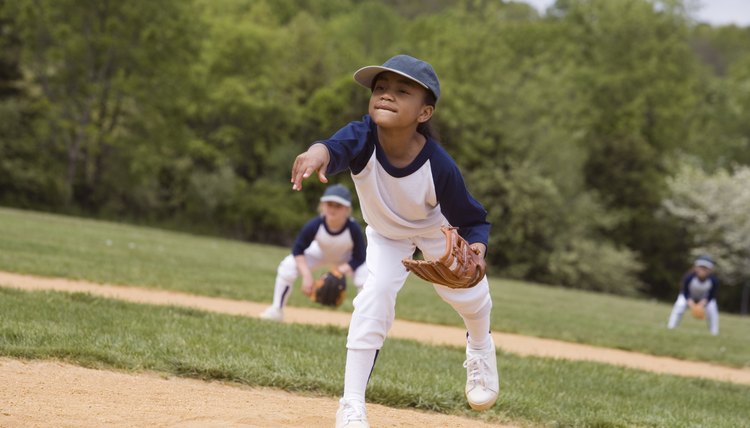How to Play Third Base in Softball

They call third base the "hot corner" for a reason. Standing just 60 feet from a dead-pull right-handed power hitter's swing, the third baseman ls often subjected to a barrage of high-velocity grounders and line drives. But don't get too far back on your heels because you're also responsible for those bunts and squibs. It takes courage, quick hands and a good throwing arm to defend the hot corner.
Know Where to Throw on Grounders
Ground balls to the third baseman get there so quickly that you need to predetermine where to throw the ball before the pitch is delivered. If there's nobody on base or there are two outs, throw the ball to first after fielding it. With a runner on first and less than two outs, go to second for an easier throw and to start a double play. With less than two outs and runners on first and second, you can touch third base if the grounder brings you near the bag, then throw to first to complete a double play. You may also decide to throw home if the bases are loaded and if you think you can throw out the runner attempting to score from third base.
Position Yourself on the Diamond
You want to be standing where the ball is hit. You need to assess the hitter's tendencies and forecast any offensive strategy they might use in order to position yourself properly. If the batter is right-handed and swings with power, you can play a few steps beyond third base. If you think the opposing coach is going to call for a bunt, then you play a few steps onto the infield grass. You might guard the foul line in a no-doubles defense late in a close game or play well off the line for a lefty pull hitter. Speak up and ask your coach for positioning guidance if you are unsure because it changes with every batter and new situation.
Fly Balls in the Air
Catch any line drives hit in your direction. Chase and catch foul-territory fly balls on your side of the infield all the way to the out-of-play fence, leaning on dugout railings and fences if you have to. Track any fly ball near you in fair territory, but concede the catch to the shortstop or left fielder if they call you off. With runners on first or second, straddle third base on any ball to the outfield anticipating a throw. But if the ball is hit into the left field corner with runners on, get in between the left fielder and catcher on the infield grass. Cut off the throw to the plate, if instructed by the catcher, to keep runners from taking an extra base.
Drop into a Defensive Stance
You want to drop into a defensive position when the hitter makes contact, making you light on your feet and ready to pounce on hard-hit balls. Watch the pitcher and get into a timing rhythm with the pitch. Take a small step with the left foot and a larger step with the right, then drop into an athletic position -- feet slightly wider than shoulder-width apart, knees bent, hinged at the hips with your weight on the balls of your feet. Extend your glove, palm up, straight down and out in front of you. Hit this ready position as the ball screams to the plate, knowing where to throw the ball on a grounder and reacting to balls hit in the air.
References
Writer Bio
Christopher Michael began writing in 2010 for Break.com. He received a Bachelor of Arts in English from the University of Massachusetts, Amherst. Writing sports and travel articles helps support his professional baseball career, which has taken him to 49 states, five continents and four oceans.
